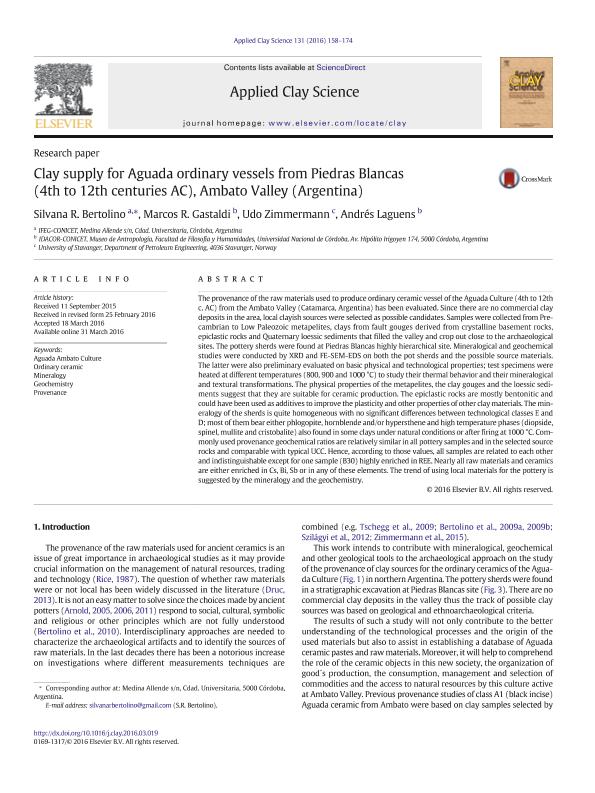Artículo
Clay supply for Aguada ordinary vessels from Piedras Blancas (4th to 12th centuries AC), Ambato Valley (Argentina)
Fecha de publicación:
10/2016
Editorial:
Elsevier Science
Revista:
Applied Clay Science
ISSN:
0169-1317
Idioma:
Inglés
Tipo de recurso:
Artículo publicado
Clasificación temática:
Resumen
The provenance of the raw materials used to produce ordinary ceramic vessel of the Aguada Culture (4th to 12th c. AC) from the Ambato Valley (Catamarca, Argentina) has been evaluated. Since there are no commercial clay deposits in the area, local clayish sources were selected as possible candidates. Samples were collected from Precambrian to Low Paleozoic metapelites, clays from fault gouges derived from crystalline basement rocks, epiclastic rocks and Quaternary loessic sediments that filled the valley and crop out close to the archaeological sites. The pottery sherds were found at Piedras Blancas highly hierarchical site. Mineralogical and geochemical studies were conducted by XRD and FE-SEM-EDS on both the pot sherds and the possible source materials. The latter were also preliminary evaluated on basic physical and technological properties; test specimens were heated at different temperatures (800, 900 and 1000 °C) to study their thermal behavior and their mineralogical and textural transformations. The physical properties of the metapelites, the clay gouges and the loessic sediments suggest that they are suitable for ceramic production. The epiclastic rocks are mostly bentonitic and could have been used as additives to improve the plasticity and other properties of other clay materials. The mineralogy of the sherds is quite homogeneous with no significant differences between technological classes E and D; most of them bear either phlogopite, hornblende and/or hypersthene and high temperature phases (diopside, spinel, mullite and cristobalite) also found in some clays under natural conditions or after firing at 1000 °C. Commonly used provenance geochemical ratios are relatively similar in all pottery samples and in the selected source rocks and comparable with typical UCC. Hence, according to those values, all samples are related to each other and indistinguishable except for one sample (B30) highly enriched in REE. Nearly all raw materials and ceramics are either enriched in Cs, Bi, Sb or in any of these elements. The trend of using local materials for the pottery is suggested by the mineralogy and the geochemistry.
Palabras clave:
Aguada Ambato Culture
,
Geochemistry
,
Mineralogy
,
Ordinary Ceramic
,
Provenance
Archivos asociados
Licencia
Identificadores
Colecciones
Articulos(IDACOR)
Articulos de INSTITUTO DE ANTROPOLOGIA DE CORDOBA
Articulos de INSTITUTO DE ANTROPOLOGIA DE CORDOBA
Citación
Bertolino, Silvana Raquel Alina; Gastaldi, Marcos Roman; Zimmermann, Udo; Laguens, Andres Gustavo; Clay supply for Aguada ordinary vessels from Piedras Blancas (4th to 12th centuries AC), Ambato Valley (Argentina); Elsevier Science; Applied Clay Science; 131; 10-2016; 158-174
Compartir
Altmétricas




